A new way to knit (2016)
Experimental / computational string art
Circular loom
The loom is an 28’’ aluminum rim, with 200 anchor pegs on its circumference.
Knitting pattern
In contrast to conventional knitting, absolutely no knitting is done inside the area of the loom. Instead, the thread is knitted as straight lines across the anchor pegs on the circumference, only. In geometric terms, the thread follows a path of consecutive circle’s chords. Thus, one single thread runs from one anchor peg to another, continuously, for 3.000 - 4.000 times, reaching a total length of 1 - 2 kilometers. Knitting is done by hand, with step-by-step instructions dictated by a computer. The absence of black thread gives a completely white color tone. The tone darkens as the density and the intersections of the black thread increase. Thus, a full grayscale palette (from black to white) is possible. Colored artwork is created from a limited palette of basic colors as black, blue, magenta, yellow and green. The combination of these basic colors can effectively produce a full color palette. The knit is transparent and can be viewed from both sides.
Pattern generation
The pattern is generated from a specially designed algorithm, coded in openframeworks (http://openframeworks.cc/ ). The algorithm takes as input a digital photograph and outputs the knitting pattern. Over 2 billion calculations are needed to produce each pattern; not much of a load for today’s computers, but definitely an impossible task for the human brain. So, this is a new and unique type of knitting that could not have been implemented a few decades ago, without computers.
Theme and aesthetics
Although any digital picture can be converted to a knitting pattern of this type, portraits are the most interesting themes. Despite the extreme limitations of the design, the depicted faces are still recognizable, but inevitably appear fuzzy and smudged; a large degree of uncertainty about the characteristics and the emotions of the depicted persons is inducted. The first series of knitted portraits is based on El Greco’s expressive figures.
Statement
How is it possible to produce a complex portrait from such a limited design?
Besides this first surprise, there are several thoughts and feelings that one could have when viewing these artworks. To me, the artworks have two intellectual cores: they reveal our poor perception over the complexity of the world and they prove the value of small and imperfect contributions to a wider cause.
The limits of our human perception becomes obvious when someone experiences the transition of looking at the artwork first from a distance and then from up-close: what seemed easily recognizable, proves to consist of unpredictable complexities. Should we wonder if our surrounding world is “tricking” us the same way? As science evolves, new tools and experiments prove that this is the case: our world is far more complicated, compared to what we think it is; our senses provide a very thin portion of reality; our experience of the world is incorrect and incomplete. These artworks challenge our poor perception of reality and prove our limited understanding of the world.
Furthermore, when someone examines carefully the artwork soon realizes that each string contributes more or less to the whole image. And each string has parts that contribute correctly on the whole image and parts that contribute incorrectly. Despite the inevitable error introduced by each string, the sum of all small and imperfect contributions allow a wider image to emerge accurately. The same idea applies to our societies: all of our actions, however intense or not, however focused or not, they can result in aimed, global and effective movements, as long as they share a common cause.
Lastly, it’s hard not to make physical and metaphorical connections to the mythological entities of Moirai (Fates) that controlled the thread of life of every mortal being, from birth to death; human life defined by a complex path of threads...
Photos of black and white artwork
Click to enlarge:

A series inspired by El Greco’s paintings
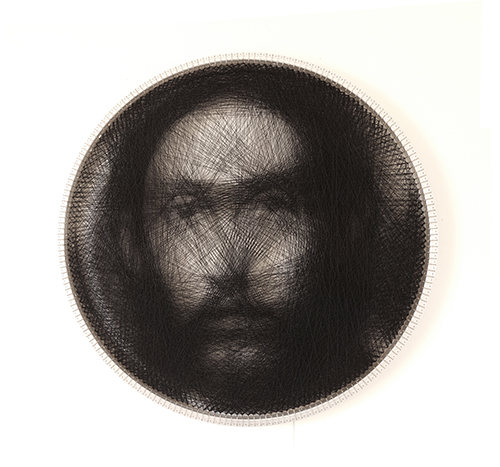
Knit inspired from El Greco’s Christ

Knit inspired from El Greco’s Christ (side view)

Detail: anchor pegs
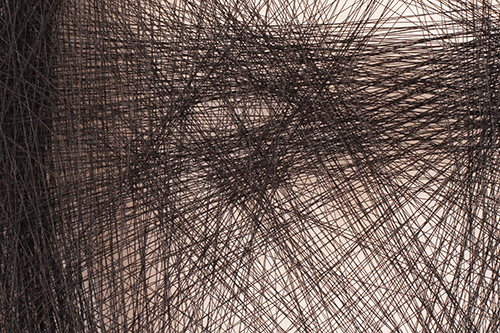
Detail: eye
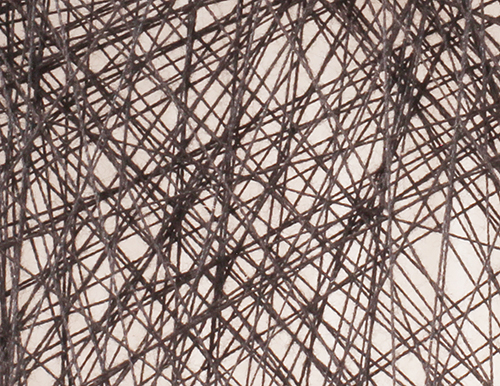
Detail: close up
Photos of colored artwork
Click to enlarge:

Artwork inspired by Botticelli's Birth of Venus
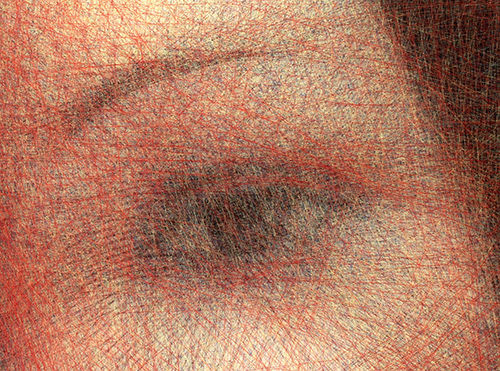
Detail: eye
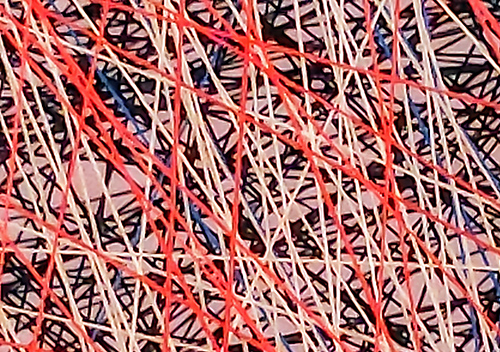
Detail: black, blue, yellow and red strings
Acceptance
The demonstration video had over 40 millions views in a just one week and received many positive comments from important internet sites and thousands of posts in the social media (facebook, twitter, blogs etc).
Reviews
The most important reviews follow:
- "Perhaps Vrellis' use of algorithms will start a movement all its own—a weaver’s revolution, enabled by technology."
The Creators Project / VICE
- "Petros Vrellis’ portraits explore the intersection of art and science."
Saatchi Art
- "Stunning knitted portraits are made of yarn and generated by an algorithm."
The Daily Dot
- "Artist Petros Vrellis shows off an amazing modern take on the string art artform."
The Awesomer
- "Artist [Petros Vrellis] has done something that we’ve never seen before."
Hackaday
- "Absolutely adore your string portraits!"
THiNC
- "A mesmerizing re-imagining of traditional handicraft."
Booooooom
- "This technological marvel is the perfect blend of art and science ... The production of such emotional and ominous art from such a methodical, mathematical approach is inspiring, and reminds us of Leonardo Da Vinci and his work."
Lost at E minor
- "Stunning El Greco-inspired portraits, all meticulously built by hand."
Gizmodo
- "Incredible Video Shows Artist Recreate A Renaissance Painting Using A Single Thread."
A Plus
Collaborations
The algorithm was used in a collaboration with MIT professors Erik Demaine and Martin Demaine, to produce a string-art font, in 2017.
Exhibitions
Since 2016 the project was hosted in various art exhibitions around the world, with the most important:
- ART Innsbruck International Fair for Contemporary Art & Antiques, Innsbruck, Austria, 2016
- Malmö International Art Fair, Malmö, Sweden, 2016
- Galleria La Pigna, Rome, Italy, 2017
- Ploes, P.&M. Kydonieos Foundation, Andros, Greece, 2017
- Adelinda Allegretti Curator Studio & Gallery, Gualdo Tadino (Umbria), Italy, 2017
- Museo del Ricamo e del Tessile, Perugia, Italy, 2019
- ArtePadova - Exhibition of modern and contemporary art market, Padua, Italy, 2021
- «Legàmi» exhibition, Oratorio del Santo Sudario, Biella, Italy, 2023
Artwork available for sale
A very limited number of the artwork is available at Saatchi Art.
Please contact us at: info@artof01.com for custom designs.